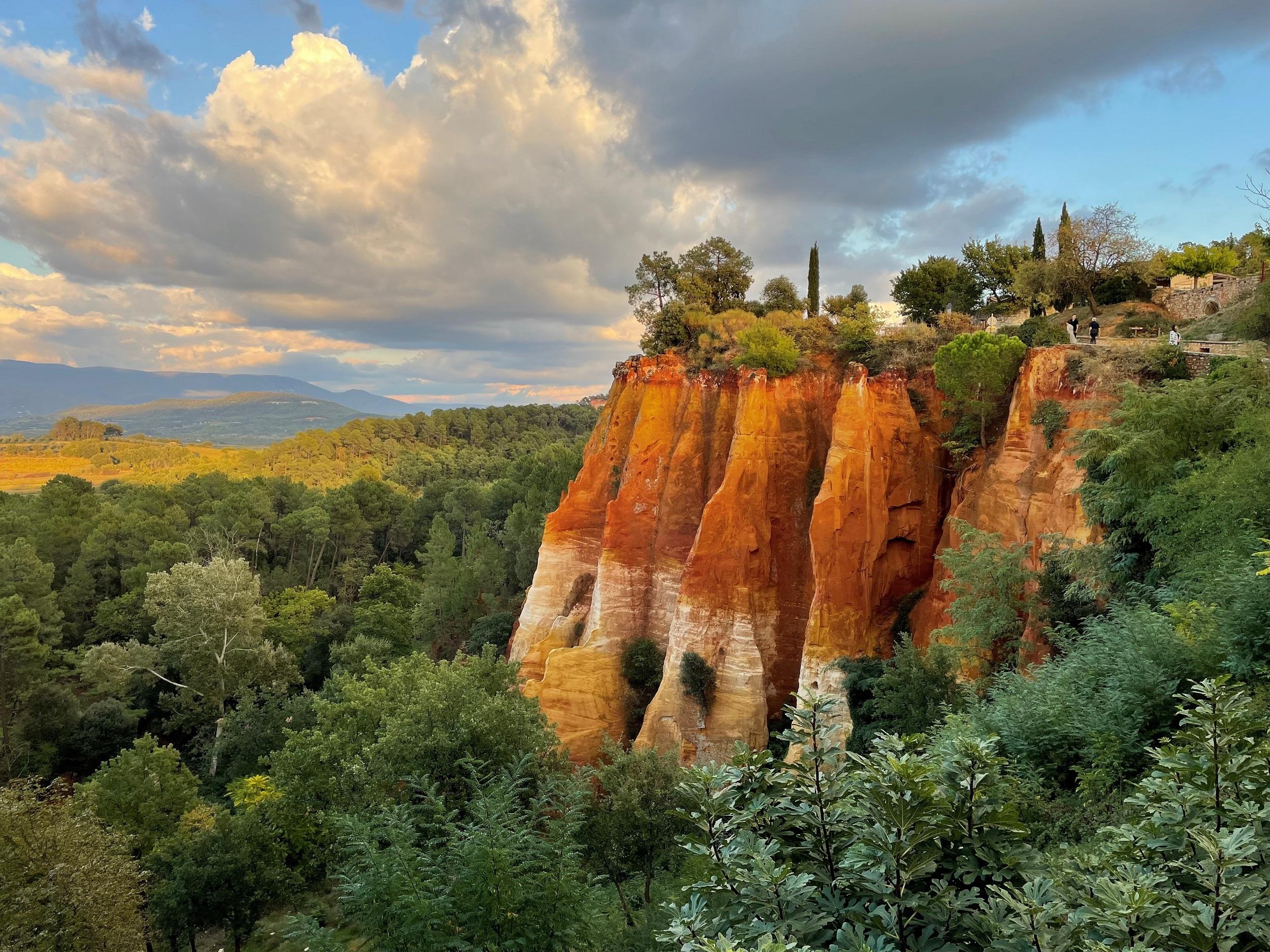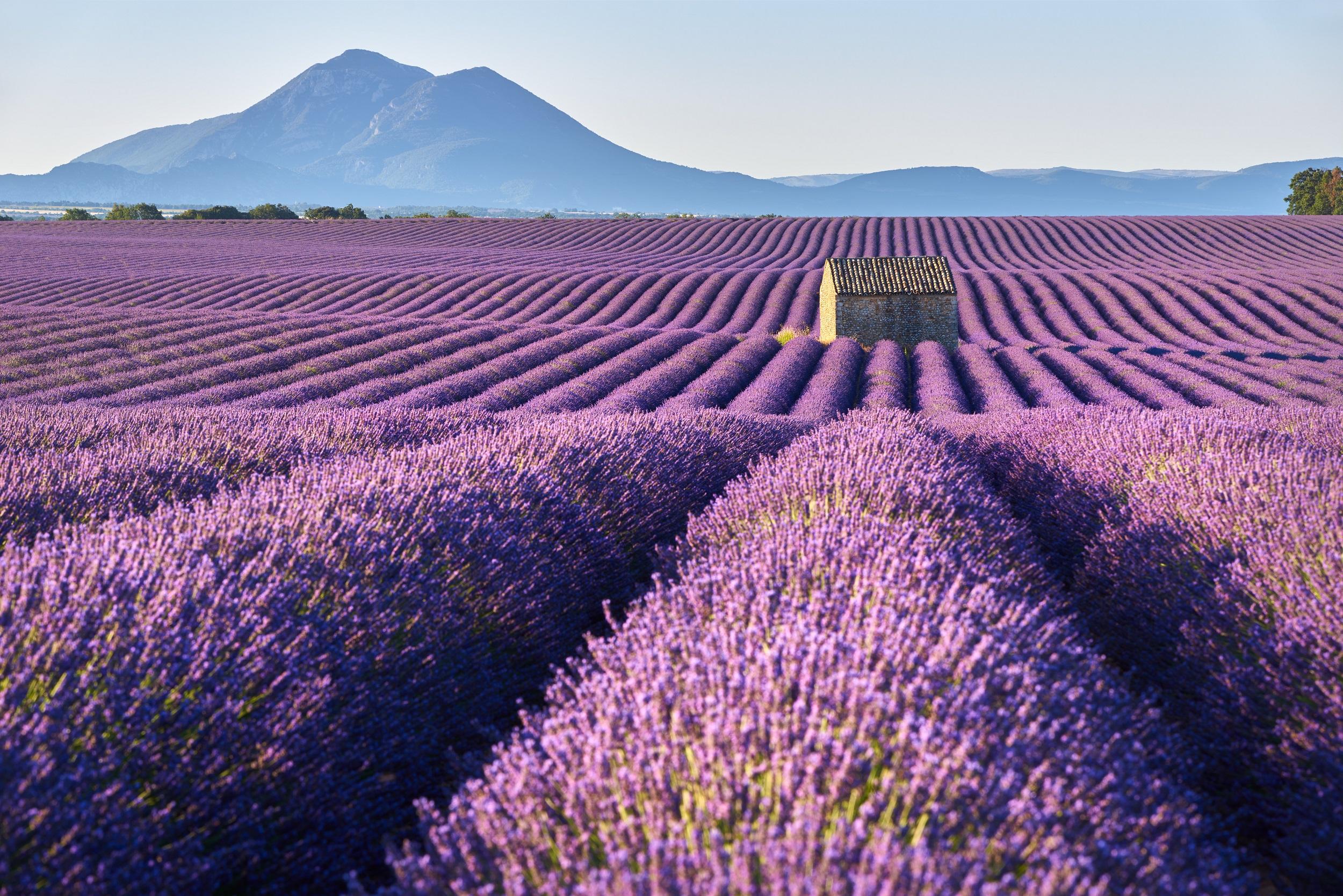Luberon: All destinations, advice & information for your holidays!
In the southeast of France, the Luberon is one of the most impressive landscapes in Provence. The limestone mountain range with the Little Luberon in the west and the Great Luberon in the east is a paradise for outdoor enthusiasts. Its forested mountains, covered with oaks and beeches, exude a mystical aura. In between, charming picture-book villages, vineyards, and lavender fields add enchanting touches.

Table of contents
Luberon - The most beautiful cities

Gordes
Situated on hills and surrounded by the typical lavender fields of Provence, the place mainly impresses with its surroundings. Also worth seeing is the Château de Gordes, a castle from the 11th century with its imposing defensive towers and the Penitents' Chapel. Notre-Dame de Sénanque, a Cistercian monastery, is also worth a visit. Hiking and cycling enthusiasts have a well-developed network of trails in the Luberon Nature Park. A route about 25 kilometers long runs along the Mur de la Peste, the Plague Wall, and crosses the Monts-de-Vaucluse. The Village des Bories near Gordes is home to several dry stone huts that were once used as shelters.

Roussillon
Only about 1,300 inhabitants live in Roussillon, which looks back on a centuries-old past. The town hall and the Romanesque parish church of St-Michel are reminders of past eras. In the village center, you will find some romantic cafés as well as the old bell tower and a color factory that has been in operation since the 19th century. Typical for the region is the ocher-rich soil, which has been mined around Roussillon since ancient times. You can learn more about it on the ocher trail at the edge of the village. On a clear day, you can see Mont Ventoux. The hilly landscape of the southern Alps is a paradise for hikers and cyclists.

Bonnieux
In Provence, the medieval Bonnieux is a charming place that delights not only hikers as part of the Luberon Nature Park. The community also pleases history enthusiasts, who find mainly architectural works here, including the Church of Saint-Gervais-et-Saint-Protais from the 12th century. The second church, built in 1870, is more accessible. In the village streets, you repeatedly come across remnants of the old city fortifications from the 13th century, fountains, and washhouses. Also interesting are the Couvent des Récollets monastery from 1605 and the old Hotel Dieu. In the bakery museum, various loaves are displayed, and you can learn about the history of bread-making there.

Ménerbes
During a tour of Ménerbes, you can discover many historic buildings. The fortress dates back to the Middle Ages, as do the citadel and the monastic church. More recent is Picasso's house. The painter, along with many other artists and writers, settled in the idyllic village. Active vacationers will find many opportunities for activities around Ménerbes. You can explore the mountainous landscape on hikes and bike tours or enjoy kayaking, climbing, or fishing. Scenic routes lead to other medieval villages in the Luberon. Golf enthusiasts can choose their favorite from several courses in the area.

Lourmarin
With its narrow cobblestone streets and old stone houses, Lourmarin is one of the most beautiful places in the country. An architectural masterpiece within it is the 15th-century Château de Lourmarin with its enchanting castle park. The first Renaissance castle in Provence is also known as Villa Medici. On literary walks and following in the footsteps of Albert Camus and Henri Bosco, you immerse yourself in history. Or discover the Luberon region on hikes and bike tours. Through fragrant lavender fields, past vineyards and olive groves, it leads into dense forests and the rocky massif.

Apt
The village of Apt in the southern French Luberon enchants visitors with its historic town center. Mansions, narrow alleys, and old fountains create a picturesque setting for a city stroll. A highlight is the Saint-Anne Cathedral, dating back to the 11th century. In the Museum of Apt, you can delve into the history of the region. During a stay in Apt, you should not miss the weekly market on the Place des Martyrs-de-la-Résistance on Saturday morning. There, you can taste regional delicacies like the famous candied fruits from traditional production or purchase locally made wickerwork. Lavender, thyme, and bay envelop you in the scent of Provence.

Lacoste
In the idyllic French mountain village of Lacoste, just 40 kilometers from Avignon and about 70 kilometers from Marseille, peace and relaxation abound. From the well-preserved medieval old town, you have a fantastic view of Mont Ventoux. A highlight is the Château de Lacoste. Once, the Château de Lacoste belonged to the famous Marquis de Sade. Today, it houses a cultural center where you can attend changing exhibitions, concerts, and theater performances. The place is also known for its art school, the Savannah College of Art and Design, founded by the American painter Bernard Pfriem in the 1970s.

Cucuron
About 70 kilometers from Avignon, the town of Cucuron boasts a rich architectural heritage. In the historic center, charming cafes, boutiques, and shops line the cobblestone streets. You can admire the town hall in an old mansion from the 14th century or the historic parish church of Notre-Dame-de-Beaulieu. In a 17th-century city palace, the Cucuron Museum traces history back to Roman times. The historic town is surrounded by the wild and unspoiled Luberon Nature Park, where you can hike through densely wooded hills and rugged limestone cliffs.
Luberon - 5 most beautiful natural sights

Nesque Gorges
The Gorges de la Nesque canyon is located in the north of Provence between the Vaucluse plateau and Mont Ventoux. A narrow scenic road leads from Villes-sur-Auzon into the canyon. The further you drive into the narrow valley, the more barren the landscape becomes. Rugged rocks tower on both sides. Active vacationers explore the Gorges de la Nesque on a hike. The long-distance hiking trail GR 9 passes through this natural paradise. You can also combine the tour with a detour to the small lake Plan d'Eau. Also worth seeing is the cave dwelling chapel St. Michel, which dates back to the 12th century.

Lake of Sainte-Croix
Lac de Saint-Croix is an artificial reservoir created in the 1970s. It is fed by the Verdon River. After passing through the famous Verdon Gorge, it flows into the reservoir. Between the gorge and the water body is the Pont du Galetas bridge. If you enjoy water sports, you will love Lac de Saint-Croix. It is a paradise for surfers and sailors. Boats can be rented at several rental stations. In the towns of Bauduen, Saint-Croix-sur-Verdon, and Les-Salles-sur-Verdon, there are well-maintained bathing areas with pebble or stone beaches. They are perfect for cooling off on hot days.

Mount Ventoux
Mont Ventoux is known for its impressive biodiversity: around 1,200 plant species are found here. This is one reason why it was designated a UNESCO Biosphere Reserve in 1990. Traditions and remnants of a cult site prove that Mont Ventoux was revered by the Celts as a sacred mountain. Gourmets will find plenty to enjoy in the region around Mont Ventoux. At the foot of the mountain lies the Côtes du Ventoux wine region, where red and rosé wines are produced, among others. Truffles are harvested on the mountain slopes. Extensive lavender fields spread a captivating fragrance in the summer.

Ocher rocks of Roussillon
In the west of Provence, the ochre cliffs of Roussillon offer an unforgettable sight. They are located in the Luberon Regional Nature Park and are remnants of old quarries from the ochre industry era. You can experience their diverse and sunlit glowing hues on a hike along the designated ochre trail Sentier des Ocres with interesting information boards. The warm colors of the quarries create a fascinating contrast to the surrounding green pines and Aleppo pines. If you want to learn more about the history of ochre mining, visit the Ôkhra - Écomusée de L'Ocre in Roussillon, which, in a former factory building, offers an exciting exhibition as well as workshops.

Plateau of Valensole
At an altitude of around 500 meters, the Plateau of Valensole in France is dotted with durum wheat and lavender fields. From mid-June to mid-July, the lavender transforms the plateau into a colorful sea of blossoms. The blooming lavender plantations are not only a visual spectacle but also emit an enchanting fragrance. Hiking and walking trails lead through the fields past olive groves and vineyards. Near the plateau, charming Provençal villages like Valensole, Riez, and Sainte-Croix-du-Verdon invite you to take a break. Discover the rich culture and history of the region or try local delicacies like the famous lavender honey.
Luberon - Climate
The following graph shows the average weather conditions for the country. Historical weather conditions may vary by region.